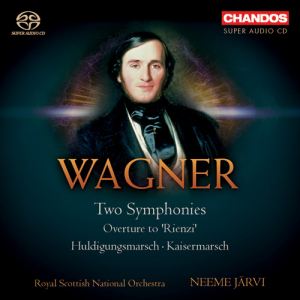 |
 |
|


alternatively
CD:
MDT
AmazonUK
AmazonUS
Downloads
from The Classical Shop
|
Richard WAGNER (1813-1883)
Symphony in C major, WWW29 (1832) [34.05]
Symphony in E major (orch. Möttl), WWW35 (1834) [19.10]
Huldigungsmarsch,WWW97 (1864) [5.16]
Kaisermarsch,WWW49 (1871)* [8.51]
Rienzi: Overture, WWW104 (1842) [11.16]
 Royal Scottish National Orchestra/Neeme Järvi
Royal Scottish National Orchestra/Neeme Järvi
rec. Royal Concert Hall, Glasgow, 19 August 2010* and 21-22 March 2011
 CHANDOS CHSA5097
CHANDOS CHSA5097  [79.14] [79.14]
|
|
|
Wagner’s little known efforts at symphonic writing have
received only a handful of recordings, and this was my first
hearing of these works. I came to the recording with foggy recollections
of Romantic Music History lectures characterizing these works
as immature juvenilia, displaying scant evidence of Wagner’s
later compositional genius. After my first listening, I quickly
came to appreciate that such characterization was unfair, and,
perhaps more importantly, incorrect.
The Symphony in C Major, written in 1832, is clearly
modelled on the symphonies of his beloved Beethoven. The first
movement opens with explosive chords, followed by woodwinds
and brass calling to one another over tremolo strings. This
introductory material soon leads into a vivacious Allegro, its
fanfare-like theme brashly proclaimed by brass and strings.
Wagner’s writing exhibits a fondness for constantly shifting
orchestral timbre, sudden dynamic contrast, and intriguingly
differentiated textures. The following Andante features
some lovely melodies, richly harmonized, while the Scherzo
is surely the most playful music Wagner ever penned. The finale
brings the expected counterweight to the first movement, explosive
right from the start. Energetic syncopated writing and a lilting
joyfulness bring Mendelssohn to mind; how Wagner would hate
that.
The liner-notes are informative and interesting, but overly
apologetic about the music’s derivative nature. As author
Emanuel Overbecke notes, “the atmosphere is entirely Beethovenian”.
The same can be said of several composers: Franz Schubert and
Ferdinand Ries immediately spring to mind. Writing after Beethoven’s
death each struggled to find his own individual voice. Surely
that does not negate the value or interest of their compositions?
At this point Wagner was intent on becoming the next great writer
of symphonies, not operas. It is a foolhardy exercise
to judge the worthiness of Wagner’s symphonic music based
on how much it reveals aspects of the mature compositional voice
we know from the operas. Rather, the question should be whether
the symphony is enjoyable and interesting enough for repeated
listening. Will repeated listening offer up new things to discover
and appreciate? Does it express some spiritual and emotional
truth to which we can connect? To all these questions, I answer
a resounding “Yes”.
The Symphony in E Major proved less enjoyable, perhaps because
its manuscript was left largely incomplete. As Overbecke explains,
it was considered lost, but was “then rediscovered, and
acquired in 1886 by Cosima Wagner who asked Felix Mottl to orchestrate
the music.” The manuscript - which was auctioned in 1913
and whose whereabouts today are unknown - consisted only of
sketches for the first movement and 30 bars of an Adagio. It
is pleasant music, but does not exhibit the same imaginative
fire found in the C Major Symphony.
Huldigungsmarsch and Kaisermarsch are festive
occasional pieces, with plenty of nationalist tub-thumping and
martial brass writing. Interestingly, Huldigungsmarsch,
which consists of four progressively faster sections, exists
in two versions. The first, completed by Wagner, is for military
band; the second version, performed here, is for full orchestra.
Wagner began its orchestration, but then, on the advice of conductor
Hans von Bülow, asked composer Joachim Raff to complete
it. Its writing bears more than a passing family resemblance
to Die Meistersinger von Nürnberg.
The most notable feature of Kaisermarsch is its use of
Martin Luther’s Ein feste Burg. It was originally
to be orchestral only, but Wagner decided to add a sacred text,
to be sung by everyone in attendance, and chose Luther’s
famous hymn for the tune. The integration of the tune into the
music is masterly, and I only wish, though it was surely cost
prohibitive, that the performance could have included singers.
Nevertheless, the performances of both marches leave little
to be desired, played, as here, with obvious relish and genuine
enthusiasm.
Somewhat daringly, this CD of little known works also includes
a performance of the Rienzi Overture, of which there
are 18 recordings currently listed at archivmusic.com. Luckily
this is an excellent performance which I found entirely convincing.
Its solemn beginning moves at a livelier tempo than is the norm
these days. The Allegro episode features resplendent orchestral
playing, especially from the brass.
The recording is up to Chandos’ usual high standards.
The orchestral sound is caught in a large acoustic, adding warmth
without any loss of clarity. The normal stereo sound layer is
splendid, but the SACD brings an extra opulent richness that
serves this music well. Greeted with enthusiasm.
David A. McConnell
See also review by Paul
Corfield Godfrey
|
|

